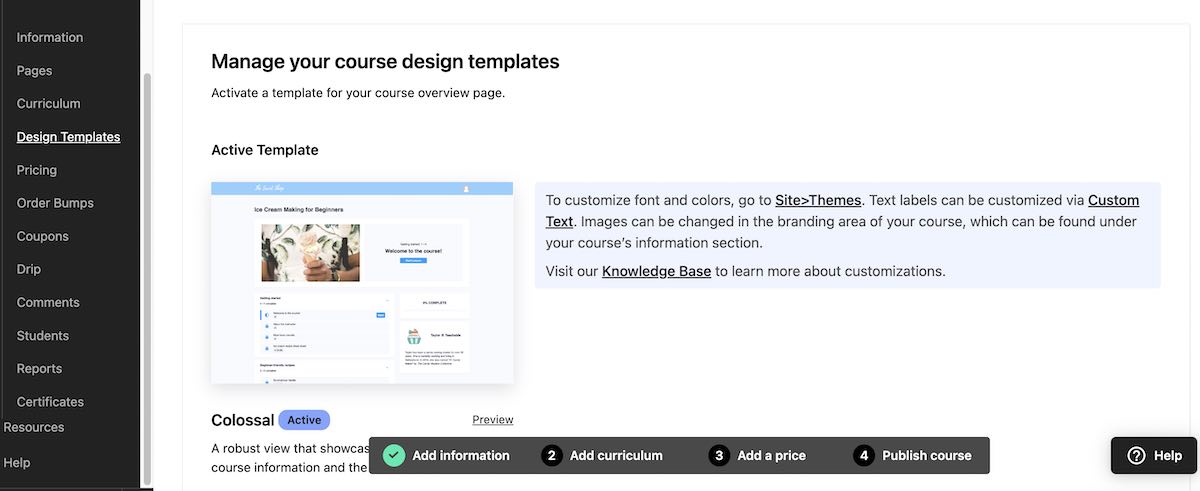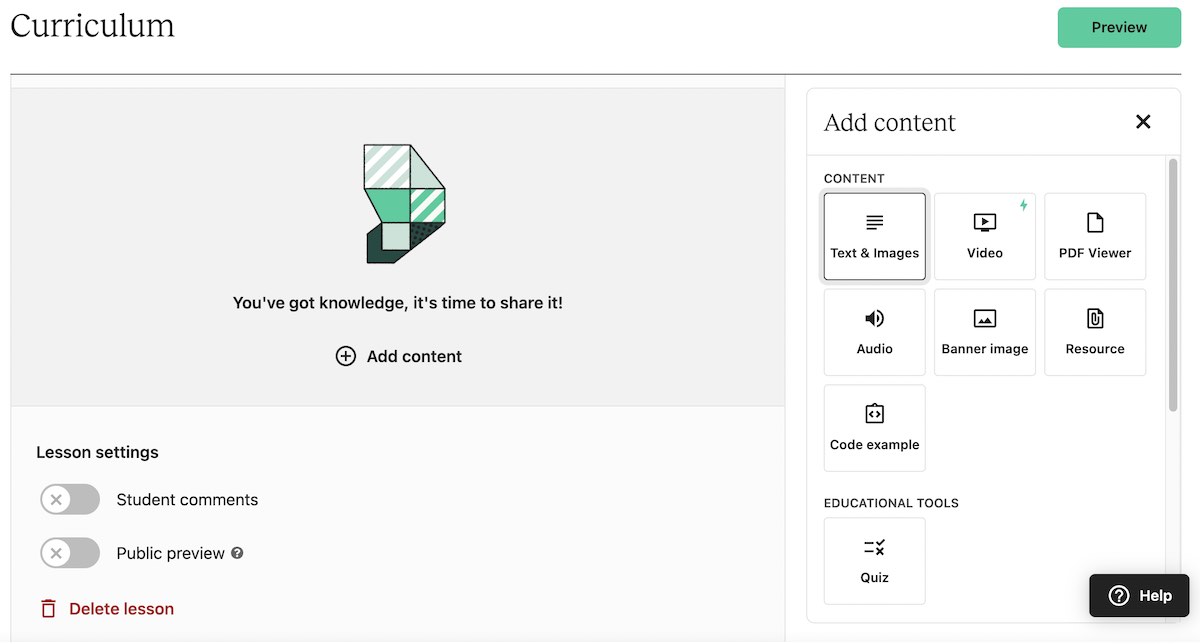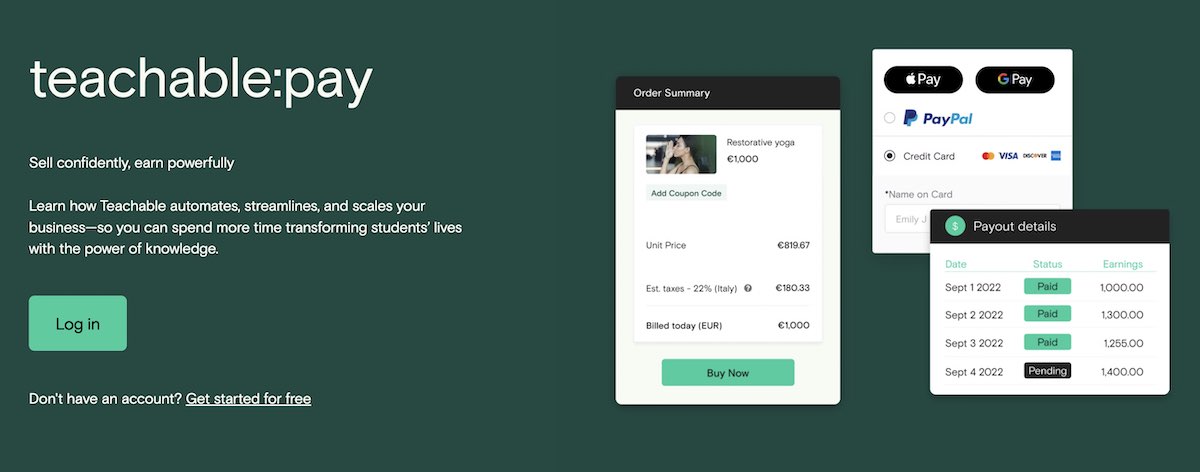If you’re interested in starting an online course business, you’ve likely considered the difference between Teachable vs. Udemy. Both Teachable and Udemy offer an affordable and accessible path to sharing your knowledge with others. However, there are several distinct differences between the two platforms.
In this comparison blog, we’ll outline the differences between Teachable vs. Udemy to help you decide which online course platform is right for you.
What is the difference between Udemy and Teachable?
Let’s start by explaining three fundamental differences between Teachable vs. Udemy.
- Course creator platforms vs. marketplaces
- Control over your course content and listings
- Compensation for course sales
Teachable is an online course creator platform—not a marketplace. In contrast, Udemy is an online marketplace, where students go to find a variety of courses, like Skillshare. It’s competitive to sell courses on Udemy, and you have little control over how your course listings appear on their marketplace. On Teachable, you have complete control over how you market and sell your courses.
While it’s free to create a course on Udemy, it has limitations. You must become a premium instructor to sell your course for a fee. Udemy also requires instructors to meet approval criteria before publishing a course. Teachable creators pay a small monthly fee to create unlimited courses and coaching—no approval necessary.
Teachable has straightforward pricing and payout options. There are no limitations on how you price your courses or get paid. In comparison, the compensation model on Udemy is confusing. Udemy uses a revenue share model to pay instructors. Payouts range from 3% – 97% of total sales revenue, depending on the lead source.
Teachable vs. Udemy: Which platform is the best for course creators?
Sharing your knowledge with others shouldn’t be stressful or complicated. Before you select a course platform, you’ll want to compare specific product features and pricing.
Teachable has everything you need to build an audience, grow, and manage your online course business. While Udemy has fewer core features and customization options, the marketplace can drive visitors to your course page.
The chart below provides a side-by-side comparison of each platform’s product features and pricing.
{{coursepricing-component="/blog-shortcodes/blog-popup"}}
In this section, we’ll go in-depth on the following product features:
- Course builder
- Course monetization
- Student learning experience
- Back-office functions
- Support resources
Course builder
Teachable
In Teachable, users can create three different types of products—courses, coaching, and digital downloads. To create a course, click the “Courses” product and select “New Course.” Once inside the course dashboard, you can create and manage your course sales page, curriculum, pricing, and more.
Teachable’s intuitive drag-and-drop builder makes building and organizing your course curriculum easy.

You can add unlimited text, videos, files, quizzes, and feedback forms within each section. You can also use the “drip” function to release lecture content on a time-based schedule.
Products like coaching and digital downloads help creators increase sales and connect with students in new ways. Like courses, you can create a digital download and set up coaching experiences in minutes. Once you’ve created a new product in Teachable, simply select “Publish” and start sharing your offer.
Udemy
The Udemy course builder is simple yet restrictive. To start the creation process, you must first identify your course learning objectives and the intended learners. Once you’ve done that, you can build your course curriculum by adding sections, lectures, and assignments. You cannot drip content on Udemy.
Unlike Teachable, Udemy has strict guidelines for video content. If you intend to offer a free course, the total length of video content must be less than 2 hours. For paid courses, you must have at least 30 minutes of video content.
You can create a landing page and select your course pricing tier inside the course builder. Unlike Teachable, you must choose from pre-determined pricing tiers ($19.99 – $199.99). The course landing page builder also has minimal design and custom branding options.
Before publishing a course on Udemy, you must submit your course for review. If your course fulfills the approval criteria, you can post it on the marketplace. However, Udemy doesn’t approve all course content.
Course monetization
Teachable
Teachable’s built-in, fully customizable sales page builder is the first step to selling your courses online. Once you’ve built a beautifully branded sales page, you can choose from various course monetization tools to boost your earning potential.
Order bumps are an easy way to increase your average order value. An order bump is a way to add another product to the checkout page. It’s usually a low-cost offer that complements your customer’s existing purchase.
You also have access to affiliate marketing and referral tools. With them, you can easily ask clients for referrals, incentivize students with discounts, and set up revenue-sharing for affiliates.
Bundles are another great way to sell complementary digital products or courses.
For example, if you sell an introductory course and an intermediate-level course, you can bundle them together and sell the bundle at a discounted rate.
Udemy
The course monetization tools on Udemy are limited. Features like order bumps, upsells, and bundles are not available on Udemy. However, instructors can use referral links and coupons to market their courses.
Referral links are an essential part of Udemy’s instructor revenue share model. Instructors who make sales via their referral link receive 97% of the revenue from the purchase. However, if the sale does not occur through an instructor’s promotion (i.e., the Udemy Marketplace), instructors only receive 37% of the revenue.
Although Udemy does offer an affiliate program, instructors have much less control over who promotes their course and how much commission they earn. Unlike Teachable, instructors cannot control commission rates or handle affiliate payouts.
Udemy instructors must rely heavily on external resources to market and sell their courses. Although the Udemy marketplace offers more visibility, marketplace sales result in less instructor revenue.
Student learning experience
Teachable
There are several built-in Teachable features that help creators build strong relationships with their students. Teachable makes it easy to create interactive, engaging course curriculums with live video streams, drip content, and more.

You can keep students engaged throughout and track retention by inserting quizzes and practical assignments at critical milestones.
Want to interact directly with students? Embed feedback forms and lecture comments to collect information and connect with students in real-time. Creators can also utilize Teachable’s email function to send unlimited updates and announcements to course students.
Creators can easily track student performance and course completion rates via the student dashboard. Inside the dashboard, you can also view video engagement rates to assess which content resonates best with students.
Another notable student management feature is Teachable is course completion certificates. For many creators, this is a critical compliance feature. Set requirements for lecture content and issue completion certificates to students who complete your course.
Udemy
Instructors have several ways to communicate directly with learners on Udemy. They can create educational announcements to re-engage learners and bring them back to the course. However, this feature does have limitations. Instructors are limited to four announcements per month and cannot promote other courses in the message.
They can also communicate with students via the direct messages function on Udemy. This tool lets you privately communicate with students or other instructors directly inside the course. You can also create an embedded Q&A forum for students to ask questions and receive specific course guidance.
Under the Performance tab in Udemy, instructors can view stats on minutes taught and active course students. Unlike Teachable’s advanced video heatmaps and student progress reports, Udemy only shows the average completion percentage for each lecture video. Additional course-level and lecture-level metrics are coming soon to the Course Engagement tab.
BackOffice functions
Teachable
Inside Teachable, creators have access to several BackOffice functions that make it easy to manage tedious, behind-the-scenes business tasks.
Let’s start with the most important task, getting paid. You can get paid daily, weekly, or monthly through its payment gateway, teachable:pay. Teachable also makes it easy for your students to pay. You can control which payment options you accept (e.g., PayPal, Stripe, Apple Pay, and credit cards) and sell your courses in over 130 currencies.

You can view detailed transaction reports via your Teachable Sales dashboard. Also, you can view monthly statements, upsell sales data, and affiliate earnings. Teachable also integrates directly with Google Analytics and Facebook Analytics, allowing you to track information on traffic sources and conversion data.
Teachable’s platform includes built-in features to help you manage taxes with ease. It also automates the process of charging, collecting, and remitting US sales tax and EU VAT for any product sold in your school.
Udemy
When it comes to back-office functions, Udemy and Teachable are relatively similar. However, Udemy does not provide the same payout flexibility and tax support services.
Instructor payout schedules are more restrictive in Udemy. Instructors are paid monthly instead of daily or weekly. When comparing student payment methods, Udemy and Teachable offer similar options. Udemy also provides a “buy now, pay later” option, which is not currently available on Teachable.
Like Teachable, Udemy users can access sales and performance data in their instructor dashboard. Under the Performance tab, you can view metrics like total revenue, traffic, and conversion data. Instructors must use the Instructor Revenue Report to view more detailed transactional data like monthly statements and tax withholdings.
Support resources
Teachable
Teachable provides several support resources to help creators at every stage of their journey. On day one, you’ll receive personalized support and guidance to help set up your school and launch your online course business. You’ll also have access to live chat and email support to help with any issues that come up.
All Teachable users, including free plans, have access to support documentation in Teachable’s Knowledge Base. This resource hub includes thousands of resources to guide you through your creator journey.
In addition, paid users get teachable:u, a robust library of content and mini-courses. It covers everything from how to use the platform to more advanced creator economy topics.
Udemy
There are a few support resources for Udemy users. However, the available resources on Udemy are far less robust than Teachable’s.
Like Teachable’s Knowledge Base, Udemy has a Teaching Center where instructors can find articles on course creation, marketing, and FAQs. However, the Teaching Center doesn’t include the same level of support and guidance in Teachable’s Knowledge Base. Similarly, Udemy doesn’t offer live group coaching sessions, personalized set-up guidance, or live chat support.
In addition to the Teaching Center, Udemy users can access two community spaces–Studio U and the Published Instructor Club. Both are spaces for current and future instructors to connect and learn from one another.
How do you make money on Teachable vs. Udemy?
You’ve invested time and energy into building your course business. And before that, you’ve likely spent hours or even years mastering your craft. It should be easy to get paid and earn what your knowledge is worth. A defining difference between Teachable vs. Udemy is how you make money.
When you sell a course or coaching on Teachable, you earn 100% of the sales revenue (minus taxes and transaction fees*). There are no hidden fees or confusing commission structures.
*Transaction fees only apply to Free and Basic plan users.
Getting paid as a Udemy instructor is much more complicated. When you sell a course on Udemy via the marketplace, you only earn 37% of the total revenue. If someone buys your course through a subscription plan, you’ll receive an even smaller portion of the total revenue. Instructors only receive the entire course revenue (97%) if students buy via their referral link.
Although Udemy markets itself as a “free” course platform, you end up paying a higher cost by giving up a large chunk of your earnings to Udemy. You have little control over your content, how it’s ranked on the marketplace, and how you earn money with Udemy.
This comparison guide reviewed some key differences between Udemy and Teachable. To summarize, Udemy is a course marketplace, whereas Teachable is a powerful yet simple online course platform. Although Udemy is free, it lacks the resources and tools to build and manage a thriving (and autonomous) online business.
With Teachable, creators can freely create and sell courses, coaching services, and digital products. You’ll get the support and guidance you need to thrive from day one. Take the next steps in sharing your knowledge business by starting a free Teachable account. In a matter of minutes, you’ll have access to everything you need to start creating and selling online courses today.
Join more than 150,000 creators who use Teachable to make a real impact and earn a real income.


.png)




